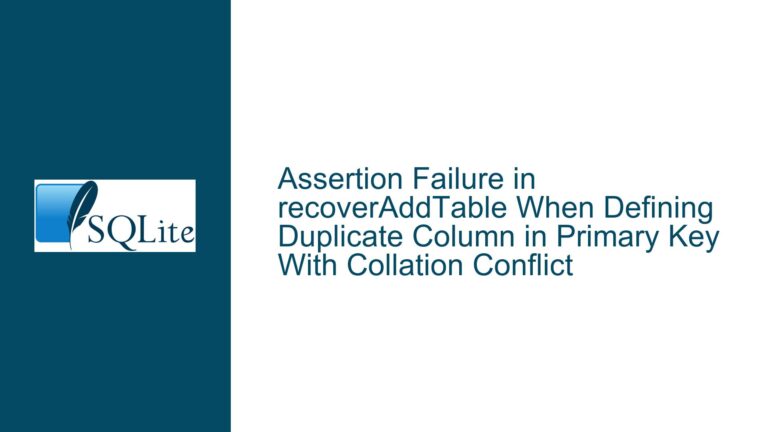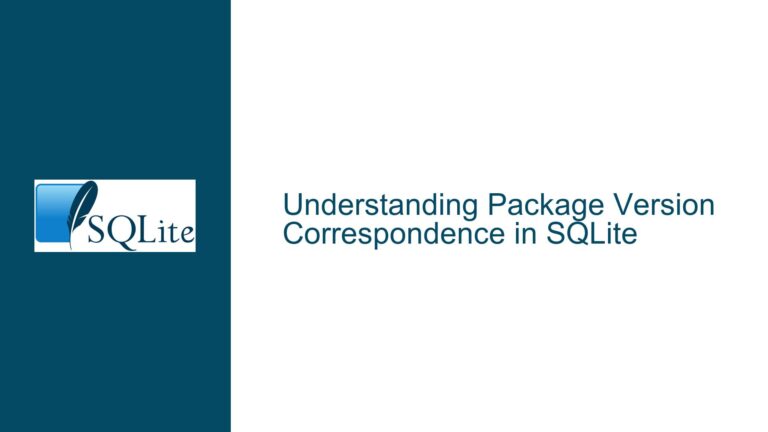Implementing File Locking in SQLite Virtual Tables for Read/Write CSV Access
Virtual Table File Locking Mechanics in SQLite: Concurrency Control for CSV Data Sources
Integrating SQLite-Compatible File Locking with Virtual Table Operations
Issue Overview: Concurrent Access to CSV Files via Virtual Tables
The challenge centers on enabling safe concurrent read/write access to CSV files using a SQLite virtual table (vtab) implementation. SQLite’s native file-locking mechanisms are designed for its database files and operate at the Virtual File System (VFS) layer. These mechanisms are not directly exposed to virtual tables, which abstract external data sources (like CSV files) as if they were native SQLite tables.
When developing a read/write virtual table for CSV files, the absence of built-in locking support at the vtab level creates risks of data corruption or race conditions when multiple processes or connections access the same CSV file. For example:
- Process A reads a CSV file through the vtab while Process B modifies it, leading to inconsistent results.
- Two processes simultaneously writing to the CSV file overwrite each other’s changes.
The SQLite VFS layer handles locking for database files using platform-independent methods (e.g., fcntl() on Unix, LockFileEx() on Windows). However, virtual tables like the CSV vtab operate outside this layer. The CSV virtual table example provided by SQLite is read-only, avoiding this problem entirely. Extending it for read/write operations requires replicating SQLite’s locking discipline manually.
Key constraints include:
- No Direct Access to VFS Locking APIs: The
sqlite3_fileandsqlite3_vfsinterfaces are internal to SQLite’s database engine. Virtual tables cannot usexLock(),xUnlock(), or related functions directly. - Transaction Boundaries: SQLite’s transaction model (BEGIN, COMMIT, ROLLBACK) does not automatically map to external data sources. The virtual table must enforce locks aligned with these transactions to maintain ACID properties.
- Platform Independence: Locking logic must function consistently across operating systems.
Conflict Drivers: Why Manual Locking Fails or Degrades Performance
Cause 1: Mismatch Between VFS Locking and Virtual Table Lifecycle
SQLite’s VFS locks database files at the connection or transaction level. For example:
- A
SHAREDlock is acquired when a read transaction begins. - A
RESERVEDlock is obtained before writing, escalating toEXCLUSIVEduring commit.
Virtual tables, however, manage external resources (like CSV files) whose access patterns do not align with SQLite’s internal locking hierarchy. A CSV vtab might open the file during xOpen(), read rows via xNext(), and close it in xClose(). For writes, xUpdate() may modify the file outside SQLite’s transactional control.
Consequence: Without explicit coordination, SQLite’s VFS locks (on the main database) do not protect the CSV file. Concurrent writes to the CSV via the vtab bypass SQLite’s concurrency safeguards.
Cause 2: Overlapping Lock Durations and Granularity
Manual locking strategies often fall into two antipatterns:
- Long-Held Locks: Locking the CSV file during
xConnect()/xCreate()and releasing atxDisconnect()/xDestroy(). This locks the file for the entire duration of the connection, eliminating concurrency. - Per-Operation Locks: Locking during
xUpdate()calls. While this minimizes lock time, frequent lock/unlock cycles introduce overhead, especially for bulk inserts.
Neither approach aligns with SQLite’s transactional model. For instance, a transaction involving multiple INSERT statements would require the CSV file to remain locked for the entire transaction, not just individual xUpdate() calls.
Cause 3: Platform-Specific Locking Semantics
POSIX (flock(), fcntl()) and Windows (LockFileEx()) locking APIs differ in behavior:
- Advisory vs. Mandatory Locks: POSIX locks are advisory by default; processes must cooperate. Windows enforces mandatory locking if the file is opened appropriately.
- Lock Inheritance: Child processes may inherit locks on some platforms.
- Lock Granularity: Byte-range locking is available but complicates CSV access, which often requires full-file locks.
A cross-platform vtab must abstract these differences, increasing implementation complexity.
Resolution Strategy: Aligning CSV File Locking with SQLite’s Transactional Workflow
Step 1: Map SQLite Transactions to CSV File Locks
SQLite virtual tables receive callbacks during transaction control:
xBegin(): Start a write transaction.xCommit()/xRollback(): End a transaction.
For a CSV vtab:
- Read Transactions: Acquire a shared lock during the first
xOpen()and release onxClose(). - Write Transactions: Acquire an exclusive lock in
xBegin(), hold untilxCommit()/xRollback().
Implementation:
// Pseudocode for SQLite vtab methods
static int csvtabBegin(sqlite3_vtab *pVTab) {
CSVTable *pCSV = (CSVTable *)pVTab;
if (pCSV->isWriter) {
// Acquire exclusive lock
if (csvFileLock(pCSV->fileHandle, EXCLUSIVE_LOCK) != SQLITE_OK) {
return SQLITE_BUSY;
}
}
return SQLITE_OK;
}
static int csvtabCommit(sqlite3_vtab *pVTab) {
CSVTable *pCSV = (CSVTable *)pVTab;
if (pCSV->isWriter) {
csvFileUnlock(pCSV->fileHandle);
}
return SQLITE_OK;
}
This ensures that write transactions hold an exclusive lock for the entire transaction, mirroring SQLite’s RESERVED to EXCLUSIVE escalation. Read transactions use shared locks, allowing concurrent readers but blocking writers.
Step 2: Implement Cross-Platform File Locking
Abstract platform-specific locking into a utility layer:
Unix/POSIX:
#include <unistd.h>
#include <fcntl.h>
int csvFileLock(int fd, int lockType) {
struct flock fl = {0};
fl.l_type = (lockType == EXCLUSIVE_LOCK) ? F_WRLCK : F_RDLCK;
fl.l_whence = SEEK_SET;
if (fcntl(fd, F_SETLK, &fl) == -1) {
return (errno == EAGAIN) ? SQLITE_BUSY : SQLITE_IOERR_LOCK;
}
return SQLITE_OK;
}
Windows:
#include <windows.h>
int csvFileLock(HANDLE hFile, int lockType) {
OVERLAPPED ov = {0};
BOOL rc;
DWORD flags = (lockType == EXCLUSIVE_LOCK) ? LOCKFILE_EXCLUSIVE_LOCK : 0;
rc = LockFileEx(hFile, flags | LOCKFILE_FAIL_IMMEDIATELY, 0, MAXDWORD, MAXDWORD, &ov);
if (!rc) {
return (GetLastError() == ERROR_LOCK_VIOLATION) ? SQLITE_BUSY : SQLITE_IOERR_LOCK;
}
return SQLITE_OK;
}
Cross-Platform Abstraction:
#define EXCLUSIVE_LOCK 1
#define SHARED_LOCK 0
int csvFileLock(void *handle, int lockType) {
#ifdef _WIN32
return winFileLock((HANDLE)handle, lockType);
#else
return posixFileLock((int)(intptr_t)handle, lockType);
#endif
}
Step 3: Handle Busy Conditions and Retries
SQLite expects SQLITE_BUSY when a lock cannot be acquired immediately. The virtual table should:
- Return
SQLITE_BUSYfromxBegin()orxOpen()if the lock is contested. - Let SQLite handle retries or propagate the error to the application.
Example:
static int csvtabBegin(sqlite3_vtab *pVTab) {
CSVTable *pCSV = (CSVTable *)pVTab;
if (pCSV->isWriter) {
int rc = csvFileLock(pCSV->fileHandle, EXCLUSIVE_LOCK);
if (rc != SQLITE_OK) {
// SQLITE_BUSY will prompt SQLite to retry based on busy_timeout
return rc;
}
}
return SQLITE_OK;
}
Configure busy_timeout via sqlite3_busy_timeout() to enable automatic retries.
Step 4: Validate Lock Coordination with SQLite’s VFS
Even though the CSV file’s locks are separate from SQLite’s database locks, conflicts can arise if:
- The CSV file is stored in the same directory as the database.
- Other processes access the CSV file outside the vtab.
Mitigations:
- Use mandatory locking (if supported) to enforce access rules system-wide.
- Document that the CSV file must only be modified via the vtab when in use.
Step 5: Performance Optimization
Problem: Frequent locking/unlocking for small writes degrades throughput.
Solutions:
- Batch Updates: Buffer modifications in memory and flush to CSV during
xCommit(). - Delayed Lock Acquisition: Defer exclusive lock acquisition until the first write operation in a transaction.
Example:
// In xUpdate(), check if the lock is already held
static int csvtabUpdate(...) {
CSVTable *pCSV = (CSVTable *)pVTab;
if (!pCSV->hasLock) {
int rc = csvFileLock(pCSV->fileHandle, EXCLUSIVE_LOCK);
if (rc != SQLITE_OK) return rc;
pCSV->hasLock = 1;
}
// Perform write
}
Step 6: Testing for Concurrency and Edge Cases
Test 1: Concurrent Readers
- Open two connections to the same CSV vtab.
- Connection A starts a read transaction.
- Connection B attempts a write; should receive
SQLITE_BUSY.
Test 2: Nested Transactions
- Ensure locks are held until the outermost transaction commits.
Test 3: Crash Recovery
- Simulate a crash during a write transaction. Verify the CSV file remains consistent (e.g., via temporary files or write-ahead logging).
Final Considerations
Implementing file locking in a SQLite virtual table requires replicating the concurrency controls typically managed by the VFS layer. By aligning lock acquisition with SQLite’s transaction callbacks (xBegin(), xCommit()), developers can ensure safe concurrent access to external data sources like CSV files. Cross-platform locking utilities and careful error handling are essential to maintain consistency and performance.






